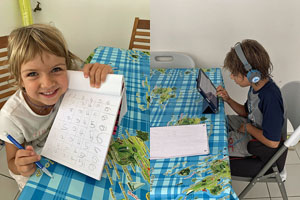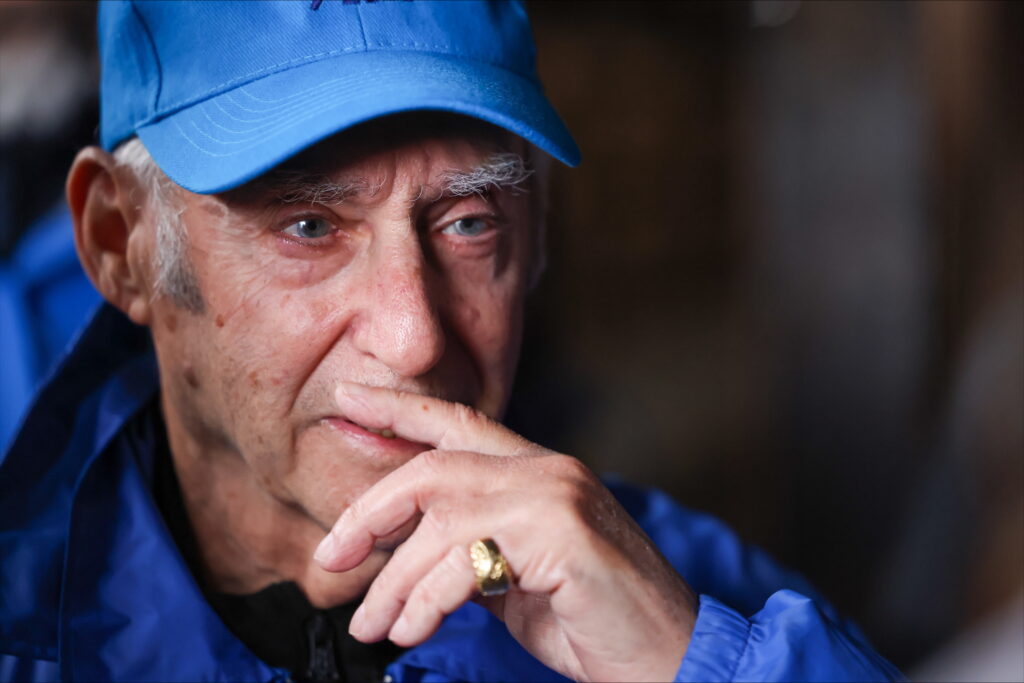Local News
Parents of Gray Academy students offer praise for “Gray Away”

By BERNIE BELLAN
At the end of my conversation with Lori Binder, Rob Dalgliesh, and Andrea Ritter about how Gray Academy has adapted to online learning, I asked Andrea whether she could suggest the names of some parents who might be willing to offer comments about how their children have taken to online learning.
Andrea sent me names of three parents: Tara Kozlowich, who has children in Grades 3 & 6; Sophie Gaulin, who has children in JK & Grade 2 (and who has been in Guadaloupe since before the pandemic due to her husband’s work); and Marla Levene, who has children in Grades 6 & 9.
In addition, I also contacted Jonathan Strauss (who was actually the individual who had suggested that I do a story about how well Gray Academy is doing with online learning.) Jonathan has boys in Grades 4 & 7.
Following are the questions I posed to Tara, Marla, and Sophie: (I simply asked Jonathan to offer some capsule comments about his impressions of “Gray Away”.)
1. How much time do both of your children typically spend doing online learning in a given day?
Tara Kozlowich: We have two daughters at the Gray Academy. One is in Grade 6 and the other in Grade 3. They spend most of their school day in a balance of live online classes and independent work. Our older daughter has dedicated times where she can attend a google meet to ask her teacher questions about assignments or to go over something in a personalized setting, similar to what you would expect in a classroom. Our younger daughter has smaller group breakout sessions which has been very helpful in teaching different concepts and providing 1 on 1 attention. They also participate in a range of other subjects such as French, Art, Gym and Music.
Marla Levine: Our children (grade 9 and grade 6) spend between 5 1/2 to 6 hours a day learning. There are also breaks in the morning and afternoon as well a lunch break.
Sophie Gaulin: Our son, Samuel is in Gr. 2 and spends in average 4 1/2 hours in total online, learning, between zoom classes and homework.
Our daughter, Charlie in JK spends about two hours total, mainly on zoom.
2. Does it vary much from day to day?
Tara: One of the great things about Gray Away is that there is consistency and structure, which is such an important part of their school day – especially in the situation we all find ourselves in. The schedule can differ by day but expectations are always clearly communicated to the kids.
Marla: Each day the amount of time spent on computer as opposed to working alone changes.
For our daughter in grade 6, there is a “meet” with her general studies teacher first thing in the morning. They spend the morning with a combination of instruction from the teacher and independent time to do the assigned tasks. At the end of the morning they have a check in before lunch. The afternoon is a similar format with the Judaic studies teacher. In addition, the other itinerants (French, art, gym, debating/public speaking, music, etc.) are spread at different times within the morning or afternoon throughout the week.
For our son in high school, the week is divided into his various classes. For any given class they may have a live meet with instruction, time to work on posted assignments with the teacher available on a meet for questions, or a combination of both. There is also small group advisory with a designated teacher to check in on the kids and how they are doing.
For elementary, the itinerants vary from day to day. The content / format for main subjects in General and Judaic studies also vary depending on what they are working on at that time. In high school, it varies from day to day (depending on what each teacher is doing in that subject on that day) as well as from class to class.
Sophie: It doesn’t vary much from one day to another.
3. How are they reacting to it? (For instance, did they adapt to it quickly? Was there a novelty aspect to it at first? Are they feeling the same way about it now as they did to start?)
Tara: They have both adapted well to the Gray Away program. Although they miss their teachers and classmates, the school has done a great job keeping them engaged and supported and they are able to connect digitally with their friends and teachers daily.
We are in a good routine with the program. Our older daughter who is in Grade 6 is independent and does not need assistance from us throughout the day. Our daughter in grade 3 needs some help each morning getting organized for the day. The structure of the program has allowed us to both work from home with minimal interruptions to our workday. Although the higher grades were already well versed in turning in assignments electronically, it’s amazing how quickly our younger daughter has picked up submitting assignments online, or taking her weekly spelling test online.
Marla: When Gray had to stop in school instruction, there was a huge unknown for everyone as to what to expect. Starting from the first day of Gray Away, our kids have been busy, engaged, happy, at ease. They are excited to see their peers and teachers. They are happy to remain connected to school. These are very uncertain times for everyone and Gray has given the kids a sense of normalcy, schedule, purpose to their day
Sophie: Our situation was a bit complicated at first because we are away in Guadeloupe. My husband was doing a locum at the hospital in NICU and PICU. We were supposed to stay on vacation only 10 days and come back mid-march but because of the COVID, he was asked to stay and help for an extended period of time.
We decided to stay together as a family but the kids didn’t have their school material and we didn’t have a printer, books… nothing. So at first it was a very stressful situation. But right away I saw why Gray is often described as a family: from Joyce Kerr, to Lori Binder, to the teachers, to Ira… we were shown an extensive solidarity that enabled us to continue their education abroad. They were sending the material every day. When we couldn’t find the material to do an activity (because we had restrictions to go out of the house for the first 6 weeks), they made sure my children didn’t feel left out.
They were amazing at providing a structured day so that the kids didn’t feel like they were on holidays but at the same time, my children feel empowered by the new learning experience. When the teacher says that they have a 30 minute break, they put their timer and go off. The system put in place is extremely organized and doesn’t require much of my time. And I have to admit it suits me fine because I work long hours remotely with my colleagues in Manitoba.
4. Do you think they are learning as much as they would be in a physical class room setting?
Tara: Although it’s hard to replicate the class room environment, they are not only learning academically, but also have the benefit of learning so many other skills such as resilience, kindness and the importance of community during difficult times. The school has done a great job of also continuing to make connections through online events whether it be for Yom Haatzmaut or a weekly Shabbat Assembly. It has been amazing to see families come together online.
Marla: We are incredibly pleased with how much our children are learning. Whether it is “as much” is easier to assess with our daughter as we can compare with what our son was learning in grade 6. It appears to us that they have not missed a beat … the teachers have modified lessons and brought in new innovative teaching, allowing the kids to flourish.
Sophie: I don’t know if they are learning as much but what I can say, is that they have not felt disconnected from school thanks to the amazing program put in place. I couldn’t believe how fast Gray was able to respond to the crisis. Within a couple days, we felt they had things under control and I felt really guided through this experience.
I feel that my children are still learning a lot. Yet they miss the real interaction with their friends and teachers.
They are also learning different skills. For instance, my 7 year-old son started writing his own emails to his teachers. So he learnt how to be responsible for sending his work or sending an email explaining why he couldn’t do it.
5. Lori mentioned that they actually have recess breaks built into the program? Do your children go outside during those recess breaks?
Tara: Our kids will often take their breaks outside for short walks or connecting with friends virtually. It’s nice to be able to spend ‘lunch recess’ with them and hear how their morning went.
Marla: The kids definitely take breaks. Sometimes that involves an outside activity and sometimes it involves an inside activity. It depends on the day and how much time they have. For example, with our son, if he happens to finish an assignment early he will often go for a walk or a bike ride or do some other type of exercise.
Sophie: Yes the schedule is very balanced. They have recess breaks and my children put the timer on and go off. Sometimes they go swimming in the pool, sometimes they go in the yard chasing lizards and caterpillars!
I invited each of the respondents to add a final comment.
Tara: Overall, our family has been so happy with Gray Away – in a short period of time the school came together quickly to launch a program that has been so well received.
It is important to mention how committed our teachers and Administration have been throughout this time – they have shown a tremendous amount of dedication to their students. Special touches like surprising the Grade 6 students with an early delivery of the coveted Gray Academy Raiders sweatshirt, or sending a personalized letter (received through regular mail!) to our younger daughter letting her know how much they miss her was such a nice surprise. These gestures have gone a long way towards our children’s happiness.
Well done Gray Academy!
Marla: We cannot thank the Gray team enough. They were able to create in a matter of days an online learning platform that should take years to launch. The administration, teachers and all staff adapted to create a learning environment that is truly remarkable. They also have gone above and beyond to check in to ensure each of our kids (and our family as a whole) is coping well with all that has come with this pandemic. We are so fortunate to have people so dedicated to our children and their well- being – educational, mental and physical. (As an aside, I should add that we have had conversations with many of our peers who are parents and our peers who work in the various educational systems. We can say confidently that there is no other private or public school that compares on any level to what is going on at Gray from an educational perspective, a connection to teachers/classmates and overall concern for emotional and physical well-being.)
Finally, here is what Jonathan Strauss had to say:
“Our family has been very impressed with how quickly Gray Away was developed and launched.
“The daily structure means that our kids are working without the need for us, as their parents, to be involved in their day to day work. From what we hear from other parents this is not the same as many other schools.
“The boys are spending much of their school day on their computers. While it is more than normal, we are happy that they are being engaged with their education for more than just a couple of hours per day.
“Seeing their friends every day on video calls means a lot to our kids. Having been separated for so long from their friends they look forward to this regular connection via Zoom.
“We can’t say enough about how pleased we are with Gray Away. Lori, her leadership teams and all of the teachers have done a tremendous job in transition quickly to online learning.”
I would really have liked to talk with individual children, and I might still do that – but I think I’ll save that for a future article.
Local News
Further to the Simkin Centre’s financial situation

By BERNIE BELLAN A while back I published an article about the deficit situation at the Simkin Centre. (You can read it at “Simkin Centre deficit situation.“) I was prompted to write that particular article after reading a piece written by Free Press Faith writer John Longhurst in the August 5 issue of the Free Press about the dire situation personal care homes in Winnipeg are in when it comes to trying to provide their residents with decent food.
Yet, Longhurst made one very serious mistake in his article when he wrote that the “provincial government, through the Winnipeg Regional Health Authority, has not increased the amount of funding it provides for care-home residents in Manitoba since 2009.”
In fact, the WRHA has given annual increases to personal care homes, but its allocations are not broken down by categories, such as food or salaries. As a spokesperson for the WRHA explained to me in an email: “PCHs receive per diem global operating funding based on the number of licensed beds they operate. This funding model is designed to support the full range of operating costs associated with resident care, including staffing, food services, utilities, building operations, and other day-to-day expenses.”
Now, one can make a perfectly valid argument that the level of funding from the WRHA has not kept up with inflation, especially inflation in food costs, but the Simkin Centre is in an even more precarious position because of the skyrocketing cost of kosher food.
“In recent years,” according to an article on the internet, “the cost of kosher food has increased significantly, often outpacing general food inflation due to unique supply chain pressures and specialized production requirements.”
Yet, when I asked Laurie Cerqueti how much maintaining a kosher facility has cost the Simkin Centre, as I noted in my previous article about the deficit situation at Simkin, she responded: “approximately $300,000 of our deficit was due to food services. I do not have a specific number as far as how much of the deficit is a result of kosher food…So really this is not a kosher food issue as much is it is an inflation and funding issue.”
One reader, however, after having read my article about the deficit situation at Simkin, had this to say: “In John Longhurst’s article on Aug 5, 2025 in the Free Press, Laurie (Cerqueti) was quoted as saying that the annual kosher meal costs at Simkin were $6070 per resident. At Bethania nursing home in 2023, the non-kosher meal costs in 2023 were quoted as $4056 per resident per year. Even allowing for a 15% increase for inflation over 2 years, the non-kosher food costs there would be $4664.40 or 24% lower than Simkin’s annual current kosher food costs. If Simkin served non-kosher food to 150 of its 200 residents and kosher food to half of its Jewish residents who wish to keep kosher, by my calculation it would save approximately $200,000/year. If all of Simkin’s Jewish residents wished to keep kosher, the annual savings would be slightly less at $141,000.”
But – let’s be honest: Even though many Jewish nursing homes in the US have adopted exactly that model of food service – where kosher food is available to those residents who would want it, otherwise the food served would be nonkosher, it appears that keeping Simkin kosher – even though 45% of its residents aren’t even Jewish – is a “sacred cow” (pun intended.)
So, if Simkin must remain kosher – even though maintaining it as a kosher facility is only adding to its accumulated deficit situation – which currently stands at $779,426 as of March 31, 2025,I wondered whether there were some other ways Simkin could address its deficit while still remaining kosher.
In response to my asking her how Simkin proposes to deal with its deficit situation, Laurie Cerqueti wrote: “There are other homes in worse financial position than us. There are 2 homes I am aware of that are in the process of handing over the keys to the WRHA as they are no longer financially sustainable.”
I wondered though, whether the Simkin Centre Foundation, which is managed by the Jewish Foundation of Manitoba might not be able to help the Simkin Centre reduce its deficit. According to the Jewish Foundation’s 2024 annual report, The Saul and Claribel Simkin Centre Foundation, which is managed by the Jewish Foundation, had a total value of $11,017,635.
The Jewish Foundation did distribute $565,078 to the Simkin Centre in 2024, but even so, I wondered whether it might be able to distribute more.
According to John Diamond, CEO of the Jewish Foundation, however, the bylaws of the Foundation dictate that no more than 5% of the value of a particular fund be distributed in any one year. There is one distinguishing characteristic about the Saul and Claribel Simkin Centre Foundation, in that a portion of their fund is “encroachable.” The encroachable capital is not owned by JFM. It is held in trust by JFM but is beneficially owned by Simkin, similar to a “bank deposit”. While held by the JFM, these funds are included in the calculation of Simkin’s annual distribution.
I asked John Diamond whether any consideration had been given to increasing the distribution that the Jewish Foundation could make to the Simkin Centre above the 5% limit that would normally apply to a particular fund under the Foundation’s management.
Here is what John wrote in response: “The Simkin does have an encroachable fund. That means that at their request, they can encroach on the capital of that fund only (with restrictions). This encroachment is not an increased distribution; rather, it represents a return of capital that also negatively affects the endowment’s future distributions.
”It is strongly recommended that encroachable funds not be used for operating expenses. If you encroach and spend the capital, the organization will receive fewer distribution dollars in the next year and every year as the capital base erodes. Therefore, the intent of encroachable funds is for capital projects, not recurring expenses.”
I asked Laurie Cerqueti whether there might be some consideration given to asking for an “encroachment” into the capital within the Saul and Claribel Simkin Centre Foundation?
She responded: “We are not in a position where we are needing to dip into the encroachable part of our endowment fund. Both of our Boards (the Simkin Centre board and the Saul and Claribel Simkin Centre Foundation board) are aware of our financial situation and we are all working together to move forward in a sustainable way.”
At the same time though, I wondered where donations to the Simkin Centre end up? Do they all end up in the Simkin Centre Foundation, for instance, I asked Laurie Cerqueti on December 15.
Her response back then was: “All donations go through our Foundation.”
I was somewhat surprised to read that answer, so I asked a follow-up question for clarification: “Do all donations made to the Simkin Centre end up in the Simkin Centre Foundation at the Jewish Foundation?”
The response this time was: “No they do not.”
So, I asked: “So, how do you decide which donations end up at the Foundation? Is there a formula?”
Laurie’s response was: “We have a mechanism in place for this and it is an internal matter.”
Finally, I asked how then, the Simkin Centre was financing its accumulated deficit? Was it through a “line of credit with a bank?” I wondered.
To date, I have yet to receive a response to that question. I admit that I am puzzled that a personal care home which has a sizeable foundation supporting it would not want to dip into the capital of that foundation when it is facing a financial predicament. Yes, I can see wanting the value of the foundation to grow – but that’s for the future. I don’t know whether I’d call a $779,425 deficit a crisis; that’s for others to determine, but it seems pretty serious to me.
One area that I didn’t even touch upon in this article, though – and it’s something I’ve written about time and time again, is the quality of the food at the Simkin Centre.
To end this, I’ll refer to a quote Laurie Cerqueti gave to John Longhurst when he wrote his article about the problems personal care homes in Winnipeg are facing: “When it comes to her food budget, ‘we can’t keep making the same number of bricks with less straw.’ “
Local News
Exclusive: Security Enhancement Fund to be announced by Province in coming days

By NOAH STRAUSS The province is set to announce a new program called the Security Enhancement Fund, which
will provide funding to religious and faith groups to improve security at institutions such as
synagogues and mosques. In an exclusive interview, Minister of Justice Matt Wiebe outlined the
plan and detailed what the province has already done to help protect Jewish Manitobans.
“What we want to do is to be able to provide the community with the kind of tools that they need
to stay safe and to ensure that everyone in the community feels safe,” said Wiebe.
The fund will provide a missing link between government and religious communities, and
communities will now be able to make their own choices without money being a big restraint.
Essentially, the power will be in the hands of community leaders and not government officials.
The minister noted that the new partnerships will provide the province a better understanding of
the needs of every community. Rather than the province making the choices, they are
essentially giving a voice to each community. The grants, totalling $1 million, will provide funds to enhance security at facilities like synagogues.
The Jewish Post reached out to Dr. Rena Secter Elbaze, executive director of Congregation
Shaarey Zedek. “It’s important that the government show us that they’re taking security seriously and stepping up to the plate to make this offer. We will absolutely be applying for grant money,” she said. Elbaze also wants to know whether or not the government will cover the costs of things the synagogue has already spent money on. She noted that the province has, in the past, made grants available to have security guards present.
When speaking about what the Justice Ministry has already done to protect Jewish Manitobans,
Wiebe brought up the new special prosecutor that is focusing on hate crimes. Wiebe said the
special prosecutor works closely with the Winnipeg Police Service “to support investigations and
prosecute hate crimes. Wiebe also went on to say how the Department of Education has been helping to fight antisemitism. “The creation of the Holocaust education curriculum is an important step in the right direction,” he said. When asked about Oliver Didtger Ederhof, the individual charged with 14 counts of mischief including vandalism of Shaarey Zedek, Wiebe said decisions like bail and police undertakings are decisions that are in part made by the federal government through the criminal code and policies. “We’re going to continue to advocate for stricter bail reform at the federal level…. I’ve been very clear, we issued clarified directives around bail to our Crown prosecutors.”
The full announcement from the province is expected in the coming days.
Local News
March of the Living 2023 participants form Taste of Hope project to help honour the memory of Holocaust survivor Alex Buckman

By BERNIE BELLAN The March of the Living is an annual two-week international educational program that brings thousands of students and adults to Poland and Israel to study the Holocaust, Jewish history, and the rise of the State of Israel. Founded in 1988, it features a 3-kilometer silent walk from Auschwitz to Birkenau on Yom HaShoah (Holocaust Remembrance Day).
Attendees on the march are accompanied by adults, some of whom themselves have been Holocaust survivors.
Following the week in Poland, participants travel to Israel to observe Yom HaZikaron (Israel’s Memorial Day) and celebrate Yom HaAtzmaut (Israel’s Independence Day), marking a journey from darkness to life.
For many years the coordinator of the march in Winnipeg was Roberta Malam, working on behalf of the Jewish Federation of Winnipeg. More recently Abby Flackman filled that role, and now the person in charge is Lindsey Kerr.
Since its inception 37 years ago the March of the Living has become a rite of passage for many young Winnipeg Jews who have been able to participate as an organized group from Winnipeg and combine visits to the death camp at Auschwitz-Birkenau in Poland with the subsequent trip to Israel.
Then – the Covid pandemic hit – in 2020, and the March of the Living was put on hold for two years – in 2020 and 2021.
In 2022, the March of the Living resumed, but there was no organized contingent from Winnipeg participating. (There may have been some Winnipeggers who did go on the march that year, but if there were any they would have been part of a general Canadian group since there was no Winnipeg coordinator that year.)
In 2023, however, once again a very large contingent of young Canadian Jews – 51 altogether, of whom approximately two-thirds were from Winnipeg, went on that year’s March of the Living. That particular march was memorable for many reasons, including the fact it was the last full march since 2019 and was to remain the last march to have an organized Winnipeg contingent in the past six years as the years 2024 and 2025 were interrupted by the war in Gaza. (There were smaller marches held in 2024 and 2025, but again there was no organized contingent from Winnipeg.)
Recently, we were contacted by one of the participants of that 2023 march, Ethan Levene, who asked us whether we’d be interested in running what turned out be a very poignant story about one particular aspect of that 2023 March of the Living.
Here is what Ethan wrote:
“In April 2023, the Coast to Coast Canadian delegation of March of the Living was privileged to travel with Holocaust survivor Alex Buckman (z”l). March of the Living is a Holocaust education trip that allows participants to visit and bear witness to the sites of the Holocaust. Unfortunately, while sharing his story in Poland, Alex passed away. However, the impact he left on us students was immeasurable.

“While speaking to us in Warsaw, Alex told us the story of his Aunt Becky’s gâteau à l’orange (orange cake). While in Ravensbruck concentration camp, his aunt managed to write down this recipe. After his parents’ murder, his Aunt Becky went on to raise Alex after surviving. In addition to sharing his story, Alex tasked us with baking the cake with family and friends.
“Out of this, a group of alumni from our trip have created this project: ‘A Taste of Hope.’ On February 1st, university students from over 5 universities across Canada will come together to bake the gâteau à l’orange and hear Alex’s story. Proceeds from the event and this fundraising page will support the World Federation of Jewish Holocaust Survivors and Descendants. Alex was heavily involved with this organization, whose mission is to both create community for Holocaust survivors and their descendants and educate about the Holocaust to help fight against antisemitism and all forms of bigotry and hate.
“Here is information from our fundraising page for the event – ‘A Taste of Hope’: Fundraising for A Taste of Hope.
Ethan added that “it’s completely student led, all by alumni from our 2023 trip attending university at these various locations across Canada; Winnipeg, London, Kingston, Montreal.”
He also added: “Follow us on instagram@tastehope.“
Here is a link to a CBC story about Alex Buckman: Alex Buckman story
In a subsequent email Ethan gave the names of Winnipeggers who are involved in A Taste of Hope: Ethan Levene (studies at McGill), Zahra Slutchuk, Alex Stoller (studies at Queens), Coby Samphir, Izzy Silver (studies at Waterloo).
He also added names of others who are involved in the project: Jessie Ages, Anneke Goodwin, Lilah Silver, Ella Pertman, Ellie Vogel, and Talia Cherun.
To find out more about March of the Living in Winnipeg go to: March of the Living


